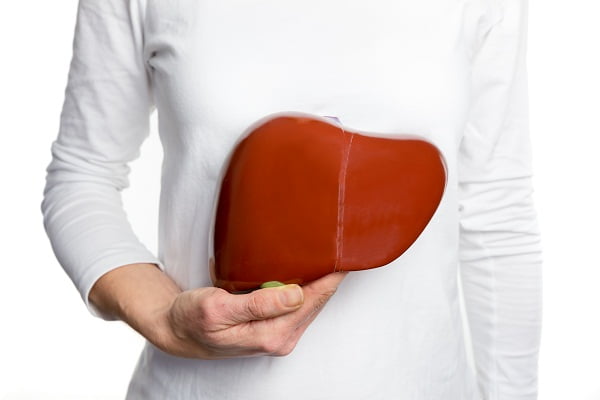What is a Liver Cancer (Hepatocellular Carcinoma)?
Primary liver cancer is a disease or condition that develops when cells of your liver become abnormal. Your liver is one of the largest organs in the body and performs several critical functions to keep the body free of harmful substances. Primary liver cancer starts in your liver. Metastatic liver cancer (secondary liver cancer) starts somewhere else and spreads to the liver later.
If you have liver cancer, the cancer cells become destructive to surrounding normal tissues. It can spread to other areas of the liver and to others organs as well. The cells can travel to other areas of the body through the bloodstream or the lymphatic system.
Liver cancer is also called hepatic cancer. The cancerous cells that develop in normal cells of the liver are called hepatocellular carcinoma.
What are the different types of liver cancer?
There are two main broad categories of liver cancer as discussed above:
- Primary liver cancer
- Secondary liver cancer (metastatic liver cancer)
The main types of liver primary liver cancer are as follows:
Hepatocellular carcinoma
Hepatocellular carcinoma (HCC), also called hepatoma, is the most common of all types of liver cancers.About 75% of all liver cancer cases are of this type. This cancer develops in hepatocytes. But it can spread from the liver to other parts of the body, such as the intestines, pancreas, intestines etc.
Cholangiocarcinoma
Cholangiocarcinoma (known as bile duct cancer) develops in bile ducts in the liver. These ducts carry bile to the gallbladder to aid in digestion. This cancer affects about 10 to 20 % of all liver cancer people. It is two types:
Intrahepatic bile duct cancer: If the cancer begins in the ducts inside the liver, it’s called intrahepatic bile duct cancer.
Extrahepatic bile duct cancer: If the cancer begins in the ducts outside the liver, it’s called extrahepatic bile duct cancer.
Hepatoblastoma
Hepatoblastoma is a rare type of liver cancer. It mostly affects children under the age of 3. The survival rate of hepatoblastoma is quite good if it is detected in the early stages.
Liver Angiosarcoma
Liver angiosarcoma is a rare type of liver cancer. It starts in the blood vessels of the liver but tends to progress fast. Generally, it is diagnosed at an advanced stage because it advances very quickly.
What are the signs and symptoms of liver cancer?
The signs and symptoms of liver cancer usually are not noticed until the cancer reaches an advanced stage. Most people don’t have signs and symptoms in the early stages of primary liver cancer. If the symptoms develop, they may include such as:
- Jaundice
- Unexplained weight loss
- Pain in abdomen
- Swelling in abdomen
- Enlarged liver
- Nausea
- Vomiting
- Fever
- Weakness and fatigue
- Loss of appetite
- Back pain
- Itching
- White and chalky stools
What are the causes of liver cancer?
The exact cause of liver cancer is not known in most cases. In some cases, the cause may be known. Liver cancer occurs when DNA mutations happen in the liver cells. This causes the cells to grow in an uncontrolled manner and form a tumor.
Chronic infection and hepatitis viruses can cause liver cancer. Most cases of liver cancer are due to a condition called cirrhosis.
Cirrhosis can occur due to several reasons. Read here about the causes of liver cirrhosis.
Are you at risk of liver cancer? What are liver cancer risk factors?
It is not clear why some people get liver cancer while others don’t get it. There are certain factors that are known to increase the risk of getting liver cancer:
Age: Liver cancer more often affects people over age 50.
Hepatitis B or Hepatitis C: Hepatitis B or C infection for a long time can severely damage your liver. Hepatitis spreads from person-to-person through direct contact with the bodily fluids of an infected person. It may also spread from a mother to her child during childbirth.
Alcohol: Too much consumption of alcohol increases the risk of liver cancer.
Cirrhosis: Cirrhosis can cause liver cancer. It is a form of liver damage in which there is scarring of liver tissues. A scarred liver can lead to serious complications, including the liver cancer.
Diabetes and obesity: Diabetes can cause you become overweight, which increases the risk of liver cancer.
Aflatoxin: Aflatoxin is a toxic substance that is produced by a type of mold that can grow on grains. In some countries, aflatoxin exposure can be high.
Over the past few decades, cases of liver cancer have increased significantly, perhaps due to increased consumption of alcohol, unhealthy diet, and obesity.
How is liver cancer diagnosed?
The diagnosis of liver cancer starts with reviewing your medical history. Your doctor will perform a physical examination. Tell your doctor if you have a history of alcohol abuse or a chronic hepatitis B or C infection or liver cirrhosis or any other disease that puts you at risk of liver cancer.
Diagnostic tests and procedures for liver cancer
- Liver function tests to determine the overall health of your liver. These tests measure the levels of proteins, liver enzymes, and bilirubin in your blood.
- Presence of alpha-fetoprotein in the blood can be a sign of liver cancer.
- Imaging: CT scan or MRI scans can provide detailed images of the liver and other organs to identify and visualize problems in the liver and nearby tissues.
- Liver biopsy: A liver biopsy includes taking a small piece of your liver tissue and testing it in a lab. Biopsy is done under anesthesia so you do not feel any pain during the procedure. It is a painless procedure.
Is liver cancer curable?
Whether the liver cancer in a particular person can be cured or not depends on various factors such as:
- the number of tumors in liver
- size of tumors in the liver
- location of tumors in the liver
- how well your liver is functioning (overall health of the liver)
- whether you have cirrhosis or not
- whether the tumor has spread to other organs (metastatic liver cancer)
How is liver cancer treated?
The treatment of liver cancer will depend on these above listed factors. The treatment may include one or more of the following:
Hepatectomy
Hepatectomy is a surgery that is performed to remove a portion or all of the liver. It is usually done when the cancer is confined to the liver and has not metastasized. After the surgery, the remaining healthy tissue will regrow to replace the removed part.
Ablation
Ablation is the use of heat to destroy cancer cells. Ablation is generally done with people who aren’t suitable for surgery or a transplant of liver. The procedure is done after local anesthesia.
Chemotherapy
Chemotherapy involves use of drugs to destroy cancer cells. Medications are injected intravenously. The side effects of chemotherapy are such as vomiting, loss of appetite, chills, loss of hair. It can also increase the risk of developing infection.
Radiation Therapy
High-energy beams of radiations are used to kill cancer cells in this procedure. Radiations can be delivered by external beam sources or with internal radiation sources.
In internal radiation, tiny radioactive particles are injected in the body. The radiations emitted by these particles destroy the hepatic artery, which is a blood vessel that supplies blood to the liver. This leads to reduced amount of blood flowing to the tumor.
Targeted Therapy
Targeted therapy works by interfering with specific abnormalities of a tumor that are vulnerable. It has been shown to slow or stop advanced hepatocellular carcinoma from advancing for a few months longer than with no treatment.
Sorafenib (Nexavar) has been approved as a targeted therapy drug for people with liver cancer. More studies are needed to understand targeted therapies better.
Liver transplant
It involves replacing the cancerous liver with a healthy liver from another person. Liver transplantation surgery may have some complications. Complications may result from the medications used during a liver transplant also such as possible rejection of the liver transplant, infection due to suppression of the immune system, high blood pressure, high cholesterol levels, diabetes, and reduced functioning of kidneys and bones.
Not everyone is eligible for a liver transplant. Candidates eligible for the liver transplant cannot have a tumor bigger than 5 cm or several tumors larger than 3 cm. The risk of returning of the cancer is great after the transplant if the tumor is larger than this size.
Embolization
Embolization is the blocking the blood supply to the cancer. This procedure involves the use of a catheter to inject particles inside the body that can block blood vessels that supply nutrition to the cancer.
If this technique uses chemotherapy, it is called chemoembolization. Complications of embolization are fever, pain in abdomen, nausea, and vomiting.
Prevention of liver cancer: Is it possible to prevent liver cancer?
Cirrhosis is the leading cause of liver cancer. Prevention of cirrhosis can help in preventing the development of liver cancer.
Regular screening for liver cancer by performing imaging tests such as ultrasound of the liver every six months in patients with a scarred liver can help detect the cancer in early stage.
Liver cancer can’t always be prevented. You can reduce the risk of developing or getting liver cancer by taking these steps:
- Get the Hepatitis B Vaccine: All children should receive this vaccine. Adults who are at high risk for infection should also be vaccinated.
- Measures to Prevent Hepatitis C: Always practice safe sex by using a condom. You should not engage in unprotected sex unless you’re sure that the partner is not infected with hepatitis or any other sexually transmitted disease. Never share needles with other people as it may lead to transmission of the infection if the person is infected. Ensure safety practices about tattoos and piercings. Go to a trustworthy shop only.
- Reduce the risk of cirrhosis: Limiting the amount of alcohol you consume can help prevent liver damage. Women shouldn’t drink more than one drink per day, and men shouldn’t drink more than two drinks per day. Maintain a healthy weight and take healthy, balanced diet. Read more about prevention of liver cirrhosis.







